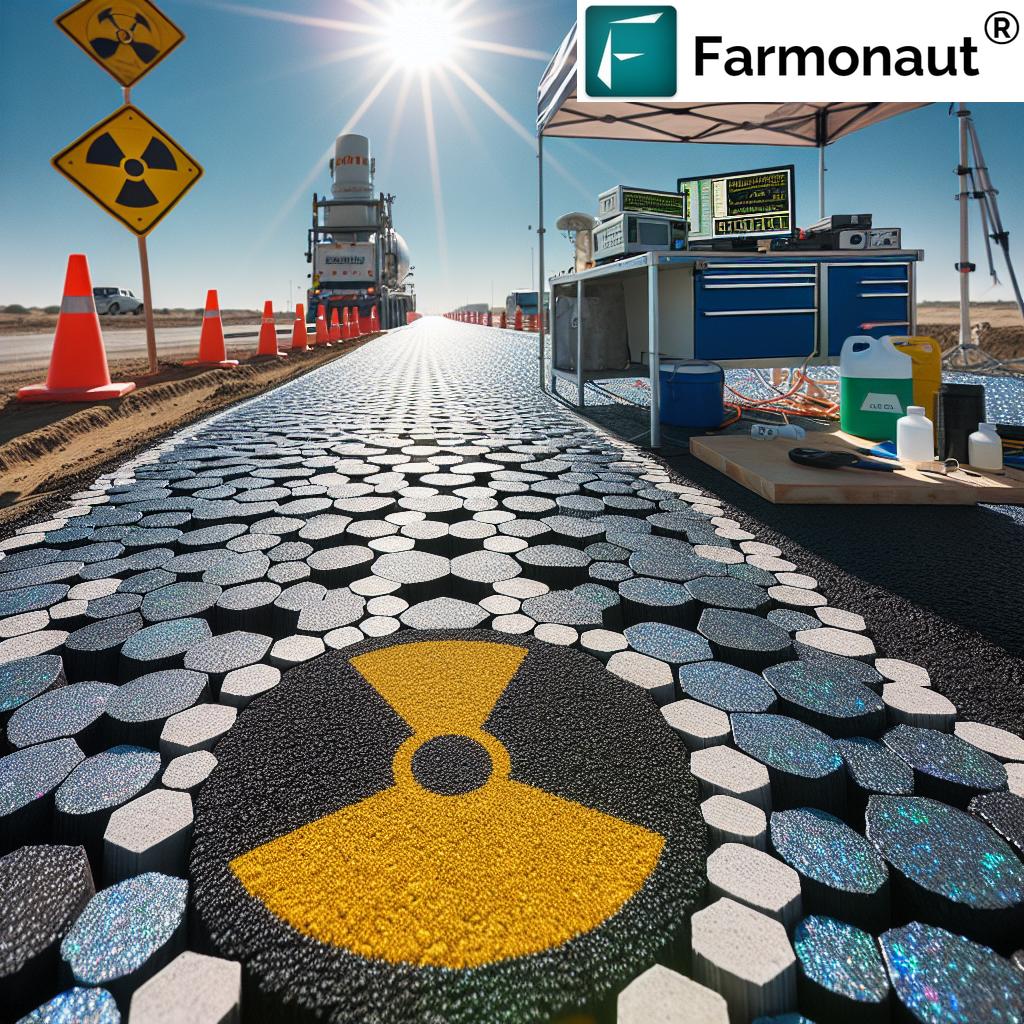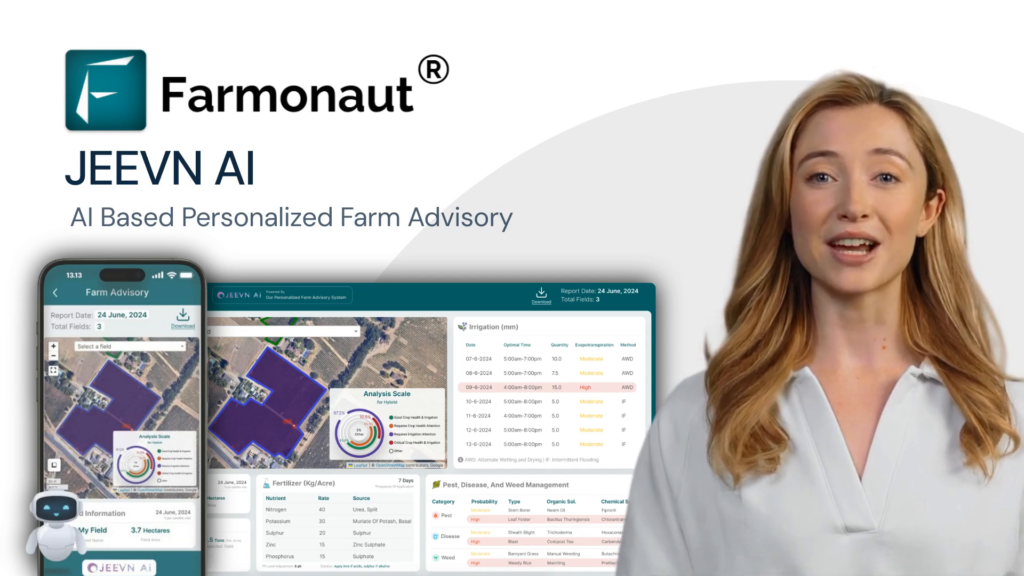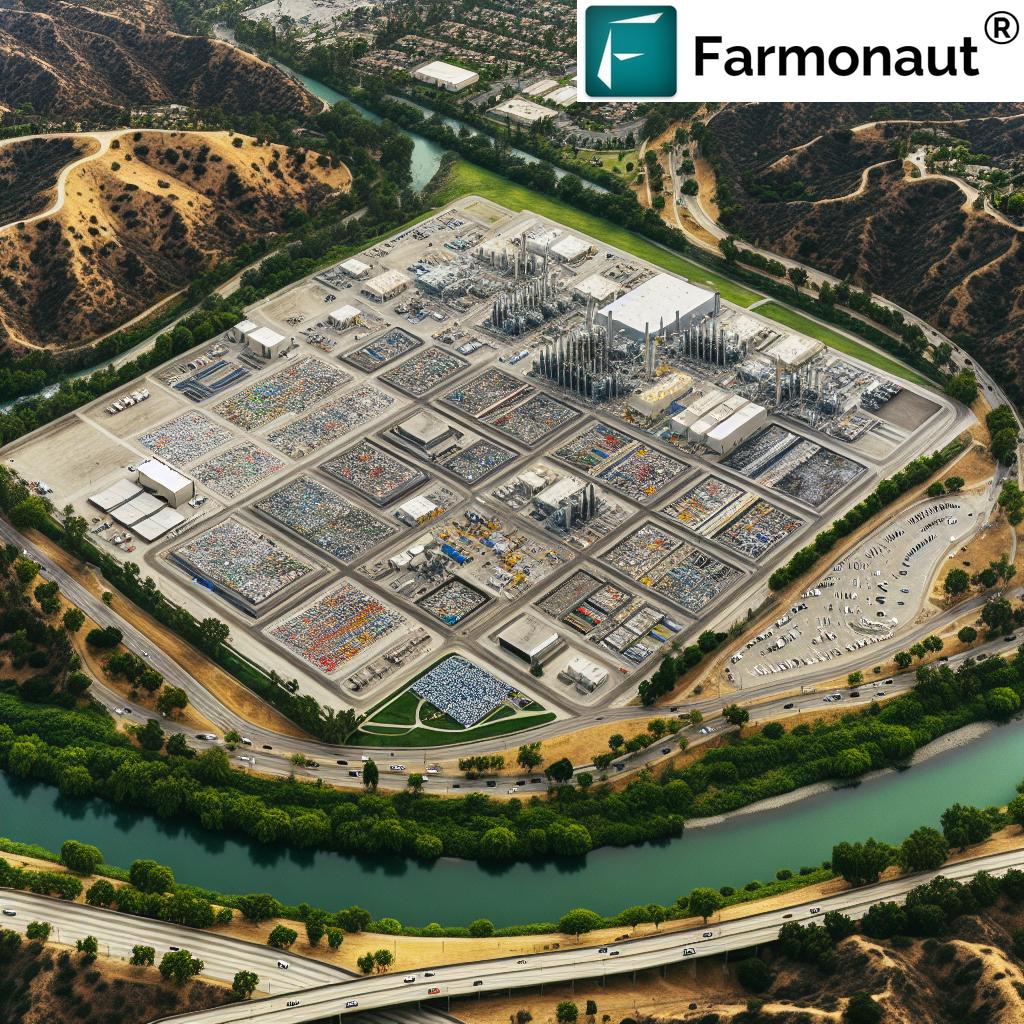Sustainable Roadways or Environmental Risk? Florida’s Radioactive Road Material Experiment Sparks Debate

“Florida’s phosphogypsum experiment aims to repurpose a billion-ton waste stockpile for sustainable road construction.”
In the heart of Polk County, Florida, a groundbreaking experiment is underway that could revolutionize road construction and waste management. The Mosaic Company, a leading producer of phosphate and potash, is spearheading an innovative project that uses phosphogypsum (PG), a radioactive byproduct of phosphate fertilizer production, as a road building material. This controversial initiative has ignited a fierce debate among environmentalists, scientists, and local residents, raising questions about the balance between sustainability and public safety.
As we delve into this complex issue, we’ll explore the potential benefits and risks associated with using phosphogypsum in road construction, the scientific analysis behind the project, and the implications for Florida’s infrastructure and environmental future. Join us as we navigate the intricate landscape of this cutting-edge experiment that sits at the intersection of innovation, sustainability, and public health.
Understanding Phosphogypsum: From Waste to Potential Resource
Phosphogypsum is a byproduct generated during the production of phosphoric acid, a key component in fertilizer manufacturing. For decades, this material has been considered waste, accumulating in massive stacks across Florida’s phosphate mining regions. However, recent scientific analysis suggests that PG could be repurposed as a valuable resource for road construction, potentially addressing two significant challenges: waste management and sustainable infrastructure development.
The composition of phosphogypsum includes:
- Calcium sulfate dihydrate (gypsum)
- Trace amounts of radium, uranium, and other radioactive elements
- Various impurities from the phosphate ore
While the presence of radioactive materials raises concerns, proponents argue that when properly managed and incorporated into road base materials, the risks can be minimized while unlocking significant environmental and economic benefits.
The Experimental Road Project in Polk County
The Mosaic Company’s experimental road project in Polk County serves as a real-world laboratory for assessing the viability of phosphogypsum in road construction. This EPA-approved initiative aims to evaluate both the engineering performance and environmental impact of PG-based road materials over an 18-month testing period.
“The 18-month EPA-approved study in Polk County, Florida will assess phosphogypsum’s viability as a road base material.”
Key aspects of the project include:
- Construction of a test road on Mosaic’s private property near Mulberry, FL
- Use of a mixture of phosphogypsum and other materials for the road base
- Application of a 4-inch thick asphalt pavement over the PG-based road base
- Continuous monitoring and evaluation of environmental impacts
- Assessment of PG’s effectiveness as a sustainable road building material
This pioneering project could pave the way for a more sustainable approach to road construction in Florida and beyond, potentially addressing the state’s billion-ton phosphogypsum stockpile while creating durable, cost-effective roadways.
The Science Behind Phosphogypsum in Road Construction
To fully understand the potential of phosphogypsum as a road building material, it’s essential to examine the scientific principles underlying its use. Researchers and engineers have been studying PG’s properties and how they can be harnessed for construction purposes while mitigating potential risks.
Key scientific considerations include:
- Material Properties: PG exhibits properties similar to natural gypsum, including high compressive strength and good water resistance when properly compacted.
- Radiation Management: The primary concern with PG is its radioactive content. However, studies have shown that when used in road base and covered with asphalt, the radiation exposure is significantly reduced.
- Leaching Potential: Research is ongoing to assess the potential for radioactive elements and other contaminants to leach into soil and groundwater.
- Durability: Early tests suggest that PG-based road materials may offer comparable or even superior durability to traditional materials in certain conditions.
As part of our commitment to sustainable agriculture and environmental stewardship, we at Farmonaut recognize the importance of innovative solutions in all aspects of land management. While our focus is on crop plantation and forest advisory services, we closely follow developments in related fields that could impact agricultural practices and rural infrastructure.
Environmental Implications and Safety Concerns
The use of phosphogypsum in road construction has sparked intense debate regarding its potential environmental impact and safety implications. Critics argue that the radioactive nature of PG poses unacceptable risks to public health and the environment, while proponents maintain that proper management and engineering can mitigate these concerns.
Key environmental and safety considerations include:
- Radiation Exposure: The primary concern is the potential for increased radiation exposure to the public and construction workers.
- Radon Gas Emissions: PG contains radium, which can decay to form radon gas, a known carcinogen. However, the asphalt layer is expected to significantly reduce radon emissions.
- Soil and Water Contamination: There are concerns about the potential leaching of radioactive materials and other contaminants into surrounding soil and groundwater.
- Long-term Environmental Effects: The long-term impact of PG roads on local ecosystems and biodiversity is yet to be fully understood.
To address these concerns, the EPA has imposed strict regulations and monitoring requirements for the experimental project. Continuous environmental testing and risk assessments will be conducted throughout the 18-month trial period to ensure public safety and environmental protection.

Regulatory Framework and EPA Approval
The use of phosphogypsum in road construction is subject to rigorous regulatory oversight. The Environmental Protection Agency (EPA) plays a crucial role in evaluating and approving such projects to ensure they meet stringent safety and environmental standards.
Key aspects of the regulatory framework include:
- EPA Approval Process: The agency conducted a thorough review of the proposed project, including risk assessments and public comment periods.
- Safety Standards: The EPA determined that the use of PG in this pilot project is “as protective of human health as placement in a stack,” setting a precedent for potential future applications.
- Monitoring Requirements: Strict protocols for ongoing monitoring and reporting have been established to track environmental impacts throughout the trial period.
- Public Disclosure: The EPA has committed to transparency, making project data and findings available to the public.
While the regulatory landscape for PG use in construction is still evolving, this pilot project represents a significant step towards establishing a framework for potential wider application of this material in infrastructure development.
Sustainability Benefits and Waste Management Potential
One of the most compelling arguments for the use of phosphogypsum in road construction is its potential to address significant waste management challenges while promoting sustainable infrastructure development. Florida’s massive stockpile of PG represents both an environmental liability and a potential resource.
Key sustainability benefits include:
- Waste Reduction: Repurposing PG could significantly reduce the volume of waste material stored in stacks across Florida.
- Resource Conservation: Using PG as a road base material could decrease the need for virgin materials, conserving natural resources.
- Energy Efficiency: PG-based road materials may require less energy to produce and transport compared to traditional materials.
- Carbon Footprint Reduction: By reducing the need for new material extraction and processing, PG use could potentially lower the carbon footprint of road construction projects.
At Farmonaut, we understand the importance of sustainable resource management in agriculture and related industries. Our carbon footprinting services help businesses track and reduce their environmental impact, aligning with the sustainability goals of innovative projects like the PG road experiment.
Economic Implications for Florida’s Infrastructure
The potential economic impact of using phosphogypsum in road construction is significant, with implications for both the phosphate industry and Florida’s infrastructure development.
Key economic considerations include:
- Cost-Effective Road Construction: PG-based road materials could potentially reduce construction costs, allowing for more extensive infrastructure improvements.
- Job Creation: The development of a new industry around PG utilization could create jobs in research, engineering, and construction.
- Reduced Waste Management Costs: Repurposing PG could significantly decrease the costs associated with maintaining and expanding waste storage facilities.
- Potential Export Opportunities: If successful, Florida could become a leader in PG-based road construction technology, potentially exporting this expertise to other regions.
While the economic benefits are promising, they must be carefully weighed against potential long-term environmental and health costs. Comprehensive cost-benefit analyses will be crucial in determining the viability of widespread PG use in road construction.
Public Perception and Community Engagement
The use of radioactive materials in road construction has understandably raised concerns among local communities and environmental groups. Public perception and community engagement play a crucial role in the success and acceptance of this innovative approach to sustainable roadway building.
Key aspects of public engagement include:
- Transparency: Open communication about the project’s goals, methods, and potential risks is essential for building trust.
- Education: Providing clear, accessible information about phosphogypsum, its properties, and the scientific basis for its use in road construction can help address public concerns.
- Community Involvement: Engaging local residents in the monitoring and evaluation process can foster a sense of ownership and ensure that community concerns are addressed.
- Addressing Health Concerns: Clear communication about safety measures and ongoing health monitoring is crucial for alleviating public anxiety about radiation exposure.
As experts in agricultural technology and sustainable farming practices, we at Farmonaut recognize the importance of community engagement in implementing innovative solutions. Our large-scale farm management tools often involve working closely with local communities to ensure that new technologies are implemented responsibly and with full stakeholder support.
Comparative Analysis: Phosphogypsum vs. Traditional Road Materials
To better understand the potential advantages and drawbacks of using phosphogypsum in road construction, it’s essential to compare it with traditional road building materials. This comparison highlights the unique properties of PG and its potential impact on road quality, durability, and environmental sustainability.
| Characteristics | Phosphogypsum | Traditional Materials | Environmental Impact |
|---|---|---|---|
| Composition | Calcium sulfate dihydrate with trace radioactive elements | Aggregates, asphalt, concrete | ⚠️ |
| Radiation Levels | Low to moderate (26 pCi/g average) | Negligible | ⚠️ |
| Durability | Potentially high when properly engineered | Varies based on material and construction | ✅ |
| Cost-effectiveness | Potentially lower due to waste repurposing | Variable, often higher due to material costs | ✅ |
| Waste Reduction Potential | High (repurposes existing waste) | Low (requires new material extraction) | ✅ |
| Long-term Environmental Risks | Potential for leaching, requires monitoring | Generally lower, well-understood | ⚠️ |
This comparison illustrates that while phosphogypsum offers significant potential benefits in terms of waste reduction and cost-effectiveness, it also presents unique challenges related to radiation management and long-term environmental impact. The ongoing study in Polk County will provide crucial data to refine this comparison and inform future decisions about PG use in road construction.
Future Prospects and Potential Applications
The experimental use of phosphogypsum in road construction in Polk County, Florida, could be just the beginning of a new era in sustainable infrastructure development. If successful, this project could pave the way for broader applications of PG and similar waste materials in construction and land management.
Potential future applications and developments include:
- Expanded Road Construction: Successful trials could lead to wider adoption of PG in road building across Florida and potentially other states with significant phosphate industries.
- Building Materials: Research into PG-based building materials could open up new avenues for sustainable construction in various sectors.
- Land Reclamation: PG could be used in land reclamation projects, potentially helping to restore areas affected by mining or other industrial activities.
- Agricultural Applications: While already used in some agricultural contexts, further research could expand PG’s role in soil amendment and crop nutrition.
- International Adoption: Successful implementation in Florida could inspire similar projects in other countries with significant phosphogypsum stockpiles.
As we consider these potential applications, it’s crucial to maintain a focus on environmental safety and public health. Ongoing research and rigorous testing will be essential to ensure that any expanded use of phosphogypsum aligns with sustainability goals without compromising ecological integrity or human well-being.
The Role of Technology in Monitoring and Management
Advanced technology plays a crucial role in ensuring the safe and effective use of phosphogypsum in road construction. From initial planning to ongoing monitoring, various technological solutions are being employed to manage potential risks and optimize performance.
Key technological applications include:
- Satellite Imaging: High-resolution satellite imagery can be used to monitor large areas for any signs of environmental impact or structural changes in PG-based roads.
- Radiation Detection Systems: Advanced sensors and monitoring equipment are essential for tracking radiation levels in and around PG road projects.
- Data Analytics: Big data analytics help researchers process and interpret the vast amounts of information gathered from ongoing monitoring efforts.
- Predictive Modeling: Computer simulations and predictive models can help anticipate long-term effects and optimize road design using PG materials.
At Farmonaut, we understand the importance of cutting-edge technology in environmental monitoring and management. Our fleet management solutions could potentially be adapted to support the logistics and monitoring needs of PG road construction projects, ensuring efficient resource allocation and environmental compliance.
Balancing Innovation and Precaution
The phosphogypsum road experiment in Florida represents a delicate balance between innovative problem-solving and cautious environmental stewardship. While the potential benefits of repurposing this abundant waste material are significant, the associated risks require careful consideration and management.
Key points to consider in this balancing act include:
- Long-term Monitoring: Establishing comprehensive, long-term monitoring programs to track environmental impacts over decades.
- Adaptive Management: Implementing flexible regulatory frameworks that can quickly respond to new data or emerging concerns.
- Continued Research: Investing in ongoing scientific studies to better understand the long-term behavior of PG in road materials.
- Public Engagement: Maintaining open dialogue with communities and stakeholders to address concerns and build trust.
- Risk-Benefit Analysis: Regularly reassessing the balance between potential environmental risks and sustainability benefits.
As we navigate this complex landscape, it’s crucial to remain open to innovative solutions while prioritizing environmental protection and public health. The lessons learned from this experiment could inform future approaches to waste management and sustainable infrastructure development not just in Florida, but around the world.
Conclusion: Paving the Way for a Sustainable Future
The phosphogypsum road experiment in Polk County, Florida, stands as a testament to human ingenuity in the face of environmental challenges. By seeking to transform a problematic waste product into a valuable resource for sustainable road construction, this project embodies the principles of circular economy and resource efficiency.
As we’ve explored throughout this article, the use of phosphogypsum in road building presents both promising opportunities and significant challenges. The potential to address Florida’s billion-ton PG stockpile while creating durable, cost-effective roadways is undeniably attractive. However, the associated risks – particularly those related to radiation and long-term environmental impact – demand careful consideration and rigorous safeguards.
The success of this experiment could have far-reaching implications, potentially revolutionizing road construction practices not just in Florida, but in phosphate-producing regions worldwide. It could pave the way for new approaches to waste management, resource conservation, and sustainable infrastructure development.
However, as we stand at this crossroads of innovation and precaution, it’s crucial to remember that true sustainability must balance environmental, economic, and social factors. The ongoing monitoring, scientific analysis, and public engagement surrounding this project will play a vital role in determining whether phosphogypsum can indeed become a cornerstone of sustainable road construction.
As we at Farmonaut continue to innovate in the field of agricultural technology and sustainable land management, we watch developments like the PG road experiment with great interest. While our focus remains on empowering farmers with cutting-edge satellite technology and data-driven insights, we recognize the interconnectedness of all aspects of environmental stewardship.
The journey towards truly sustainable infrastructure is complex and often controversial, but it’s through bold experiments and careful study that we can hope to find solutions to our most pressing environmental challenges. As Florida’s radioactive road material experiment unfolds, it serves as a reminder of the importance of innovation, scientific rigor, and open dialogue in shaping a more sustainable future for all.
FAQs
- Is it safe to drive on roads made with phosphogypsum?
According to current research and EPA assessments, properly constructed PG roads covered with asphalt are considered safe for public use. However, long-term studies are ongoing to confirm this. - How does the radiation in phosphogypsum compare to natural background radiation?
While PG does contain higher levels of radiation than typical soil, when used in road construction and covered with asphalt, the radiation exposure is generally comparable to or only slightly above natural background levels. - Could phosphogypsum roads contaminate groundwater?
This is a key concern being studied in the Polk County experiment. Proper engineering and containment measures are designed to minimize leaching, but long-term monitoring is crucial to assess any potential groundwater impacts. - How long will the experimental road in Polk County be monitored?
The initial testing phase is set for 18 months, but long-term monitoring plans extend well beyond this period to assess any potential environmental impacts over time. - Could this technology be used in other states or countries?
If proven successful and safe, the technology could potentially be applied in other regions with significant phosphogypsum stockpiles, subject to local regulations and environmental assessments.
For more information on sustainable agricultural practices and innovative land management solutions, visit Farmonaut.com. Our advanced satellite-based farm management tools can help you optimize your agricultural operations while promoting environmental stewardship.
Earn With Farmonaut: Join our affiliate program and earn a 20% recurring commission by helping farmers save 10% with your promo code. Onboard 10 Elite farmers monthly to earn a minimum of $148,000 annually—start now and grow your income!
Learn more about our affiliate program
Experience the power of precision agriculture with Farmonaut:




















